

Overleaf - LaTeX: Bibliographies and Citing
- Getting Started
- Creating a LaTeX Document in Overleaf
- Structuring and Formatting
- Lists, Tables, Images, and Labelling
- Mathematics in LaTeX
- Bibliographies and Citing
- Books and Dissertations
- Submitting from Overleaf
Bibliographies in LaTeX
In order to cite references, you first need to create a separate bibliography file ending with a .bib extension within your LaTeX project. You can do that by clicking on the New File icon on the upper-left corner of the screen.

Then, enter your file name. Note that the default file extension in LaTeX is .tex. Your bibliography file must end in .bib. Once you create your file, you can add references to it in the BibTeX format.
Exporting references from ProQuest RefWorks
If you use RefWorks to manage your references, you can export your references from RefWorks into the BibTeX format. To export your references from RefWorks, click on the Share tab. Then, click on Export References and select the BibTeX option. You can import the references you exported from RefWorks into LaTeX as a .bib file.
To learn more about RefWorks, visit the RefWorks e-course module .
Exporting references from a database or Google Scholar
The easiest way to add references to your .bib file, other than exporting them from RefWorks, is to import or copy them directly from Google Scholar or from a database. To cite from Google Scholar, click on the cite icon underneath the article, which is represented with a quotation sign. Select the option BibTeX at the bottom of the pop-up screen. You will be directed to another page where you can copy the reference in the BibTeX format. Make sure to check that the relevant fields are entered correctly before copying the reference into your .bib file.
Note that Google Scholar does not include a DOI, which is often needed as part of your reference.
Some databases also provide the option to export a reference in the BibTeX format. The way to export a reference from a database can vary depending on the database being used.
Note: Not all databases allow you to export citation information in the BibTeX format. To work around this, use RefWorks to manage your references which you can then export in the BibTeX format.
Entering references manually
When entering a reference to BibTeX, the fields that are required to be filled in for each citation will vary depending on the type of the work you are citing. The reference type is specified by using the @ symbol followed by the type. Regardless of the reference type, the first field to be entered in the reference is the label that you want to give to a particular reference. You will later be able to use this label to cite the reference in the main text of the document.
Below is an example of the fields you are required to enter for articles.
Here's another example illustrating the fields required for a Ph.D. thesis.
Visit the page on standard templates for BibTeX to see how other types of works can be included.
Citing in LaTeX
To begin citing sources within your LaTeX document, you can use the biblatex package. Add \usepackage { biblatex } to your preamble. Note that there are other packages that you could use for this, including the natbib package, which is also a popular option.
There are a number of specifications you can enter to the \usepackage { biblatex } command. The first specification you should add within the square brackets of the command is backend = biber . Biber provides the relevant information needed to implement the biblatex package.
You can also specify the style of your bibliography by using the style parameter. For instance, style=authoryear will print your references in the author-year format. Another common variant is style=authoryear-comp , which will only print the author's last name once, and not for the subsequent references. Visit the page on biblatex's citation styles for a full list.
Using biblatex, you can also determine what criteria should be used to sort your bibliography by specifying the sorting parameter. For instance, sorting=nyt will sort your bibliography by name, title, and year. The end result of specifying these parameters may look something like this:
To be able to cite the references from your bibliography, you will need to implement a command mapping your BibTeX file to your document. To do that, you can use the \addbibresource {..} command and add your file name in between the curly brackets.
There are many options to call and format your in-text citations in LaTeX. Below is a list of common commands you can use with the corresponding output. For instance, the command \parencite {JonesandSmith1997} will result in (Jones and Smith 1997) in the pdf.
Adding the \printbibliography command at the end of the document will instruct LaTeX to print your references.
- << Previous: Mathematics in LaTeX
- Next: Books and Dissertations >>
- Last Updated: Mar 14, 2022 9:28 AM
- URL: https://libguides.eur.nl/overleaf
LaTeX-Tutorial.com
Bibliography in latex with bibtex/biblatex, learn how to create a bibliography with bibtex and biblatex in a few simple steps. create references / citations and autogenerate footnotes., creating a .bib file, using bibtex.
- Autogenerate footnotes with BibLaTeX
- BibTeX Format
BibTeX Styles
- New Post! Export Bibliographic Database (BibTeX) Entries from Online Databases
We have looked at many features of LaTeX so far and learned that many things are automated by LaTeX. There are functions to add a table of contents, lists of tables and figures and also several packages that allow us to generate a bibliography. I will describe how to use bibtex and biblatex (both external programs) to create the bibliography. At first we have to create a .bib file, which contains our bibliographic information.
A .bib file will contain the bibliographic information of our document. I will only give a simple example, since there are many tools to generate the entries automatically. I will not explain the structure of the file itself at this point, since i suggest using a bibtex generator (choose one from google). Our example will contain a single book and look like this:
If you don’t want to use a BibTeX generator or a reference management tool like Citavi (which generates BibTeX files automatically for you), you can find more examples of BibTeX formats here.
After creating the bibtex file, we have to tell LaTeX where to find our bibliographic database. For BibTeX this is not much different from printing the table of contents. We just need the commands \bibliography which tells LaTeX the location of our .bib file and \bibliographystyle which selects one of various bibliographic styles.
By using this code, we will obtain something like this:

I named my .bib file lesson7a1.bib, note that I did not enter the .bib extension. For the style, I’ve choosen the ieeetr style, which is very common for my subject, but there are many more styles available. Which will change the way our references look like. The ieeetr style will mark citations with successive numbers such as [1] in this example. If I choose the style to apalike instead, i will get the following result:

Most editors will let you select, to run bibtex automatically on compilation. In TeXworks (MiKTeX) for example, this should be selected by default.
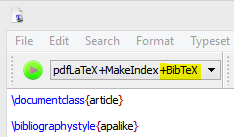
If you use a different editor, it can be necessary to execute the bibtex command manually. In a command prompt/shell simply run:
It is necessary to execute the pdflatex command, before the bibtex command, to tell bibtex what literature we cited in our paper. Afterwards the .bib file will be translated into the proper output for out references section. The next two steps merge the reference section with our LaTeX document and then assign successive numbers in the last step.
Autogenerate footnotes in \(\LaTeX\) using BibLaTeX
The abilities of BibTeX are limited to basic styles as depicted in the examples shown above. Sometimes it is necessary to cite all literature in footnotes and maintaining all of them by hand can be a frustrating task. At this point BibLaTeX kicks in and does the work for us. The syntax varies a bit from the first document. We now have to include the biblatex package and use the \autocite and \printbibliography command. It is crucial to move the \bibliography{lesson7a1} statement to the preamble of our document:
The \autocite command generates the footnotes and we can enter a page number in the brackets \autocite[1]{DUMMY:1} will generate a footnote like this:

For BibLaTeX we have to choose the citation style on package inclusion with:
The backend=bibtex part makes sure to use BibTeX instead of Biber as our backend, since Biber fails to work in some editors like TeXworks. It took me a while to figure out how to generate footnotes automatically, because the sources I found on the internet, didn’t mention this at all.
BibTeX Formats
This is not meant to be a comprehensive list of BibTeX formats, but rather give you an idea of how to cite various sources properly. If you’re interested in an extensive overview of all BibTeX formats, I suggest you to check out the resources on Wikibooks.

Inbook (specific pages)

This is a list of the formats that I have most commonly used. If you think some important format is missing here, please let me know.
Here’s a quick overview of some popular styles to use with BibTeX.
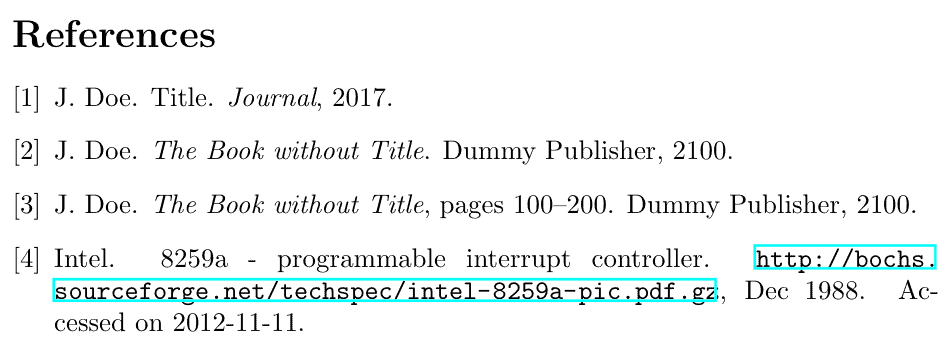
I’m trying to keep this list updated with other commonly used styles. If you’re missing something here, please let me know.
- Generate a bibliography with BibTeX and BibLaTeX
- First define a .bib file using: \bibliography{BIB_FILE_NAME} (do not add .bib)
- For BibTeX put the \bibliography statement in your document , for BibLaTeX in the preamble
- BibTeX uses the \bibliographystyle command to set the citation style
- BibLaTeX chooses the style as an option like: \usepackage[backend=bibtex, style=verbose-trad2]{biblatex}
- BibTeX uses the \cite command, while BibLaTeX uses the \autocite command
- The \autocite command takes the page number as an option: \autocite[NUM]{}
Next Lesson: 08 Footnotes
- Plagiarism and grammar
- Citation guides
Cite a Website in BIBTEX
Don't let plagiarism errors spoil your paper, consider your source's credibility. ask these questions:, contributor/author.
- Has the author written several articles on the topic, and do they have the credentials to be an expert in their field?
- Can you contact them? Do they have social media profiles?
- Have other credible individuals referenced this source or author?
- Book: What have reviews said about it?
- What do you know about the publisher/sponsor? Are they well-respected?
- Do they take responsibility for the content? Are they selective about what they publish?
- Take a look at their other content. Do these other articles generally appear credible?
- Does the author or the organization have a bias? Does bias make sense in relation to your argument?
- Is the purpose of the content to inform, entertain, or to spread an agenda? Is there commercial intent?
- Are there ads?
- When was the source published or updated? Is there a date shown?
- Does the publication date make sense in relation to the information presented to your argument?
- Does the source even have a date?
- Was it reproduced? If so, from where?
- If it was reproduced, was it done so with permission? Copyright/disclaimer included?
- Citation Machine® Plus
- Citation Guides
- Chicago Style
- Harvard Referencing
- Terms of Use
- Global Privacy Policy
- Cookie Notice
- DO NOT SELL MY INFO
- Introduction to BibTex
- Cite References in LaTex
- LaTex Resources
- From Web of Science
- From Scopus
- From Engineering Village
- From MathSciNet
- From Google Scholar
- From ACM Digital Library
- From IEEE Xplore
- BibTex Entries for Books
- Export from EndNote
- Export from Mendeley
- Export from Zotero
BibTex and LaTex: Cite References in LaTex
How to cite references in latex.
Insert the command below to where you want to cite in your LaTex document:
\cite{BibTexKey}
If you want to create a bibliography of all references, use this command:
\nocite{*}
How to Create Bibliography in LaTex
The following two commands are used to create bibliography/reference list:
\bibliographystyle{StyleType}
\bibliography{BibTexFileName}
The built-in bibliography styles in LaTex include:
- plain: references listed in alphabetical order and labeled numerically
- unsrt: same as plain except references appear in order of citation
- alpha: same as plain except labeled by entry
- abbrv: same as plain except use abbreviations for first names and journal names
- acm: ACM style
- ieeetr: IEEE style
How to Typeset a LaTex Document
Once you finish writing and citing in Latex, you need to run the following four commands to generate PDF file with bibliography:
Watch the video on the right to find out how to cite, create bibliography, and typeset LaTex file in TexStudio.
A Sample LaTex File with Citations
In this simple LaTex document, five BibTex entries are cited. The bibliography style used is "plain", and the BibTex entries are from the database "Mybibtex".
\documentclass{article}
\begin{document}
\title{About JabRef} \author{Author Name}
JabRef is an open source reference management software for BibTex \cite{BESIIICollaboration2014}. It has graphic interface, which makes it easy to use \cite{Apalkov2013,Libby2014}. This is why we choose it as our preferred reference management software for BibTex\cite{Silveira2014}. We will explain the features in details in this section \cite{Uematsu2015}.
\bibliographystyle{plain} \bibliography{Mybibtex}
\end{document}
Change Bibliography Style in LaTex
Sometimes, you need to change your bibliography styles in LaTex. This can be completed by changing the style name in the command:
\bibliographystyle{AnotherStyleType}
The video below gives more details on how to change a bibliography style in LaTex. Click the Full Screen button to enlarge the video.
Video: How to Typeset LaTex Document
This video shows you how to cite, create bibliography, and typeset LaTex file in TexStudio. Click the Full Screen button to enlarge the video.
- << Previous: JabRef
- Next: LaTex Resources >>
- Library A to Z
- Follow on Facebook
- Follow on Twitter
- Follow on YouTube
- Follow on Instagram
The University of Saskatchewan's main campus is situated on Treaty 6 Territory and the Homeland of the Métis.
© University of Saskatchewan Disclaimer | Privacy
- Last Updated: Jan 8, 2024 4:49 PM
- URL: https://libguides.usask.ca/bibtex
How to Cite a Website in BibTeX
BibTeX is a tool and a file format used for managing citations and bibliographies in LaTeX documents. Since citing websites requires a hack, there are a few things to remember when referencing a website in a BibTeX document. To simplify matters, BibLaTeX was developed.
Need a simple solution for managing your BibTeX entries? Explore CiteDrive!
- Web-based, modern reference management
- Collaborate and share with fellow researchers
- Integration with Overleaf
- Comprehensive BibTeX/BibLaTeX support
- Save articles and websites directly from your browser
- Search for new articles from a database of tens of millions of references
Overleaf and R Studio are just two of the many online publishing platforms that CiteDrive synchronizes with automatically. In order to facilitate citing academic articles in, say, an Overleaf project, we provide a browser extension that lets you do so without leaving the browser and in the proper BibTeX format. The extension can also be used to save web pages in BibLaTeX format, which will record the page’s title, URL, and access date automatically.
Basic Format
The basic format for citing a website in BibTeX is as follows:
In this format, the label is a unique identifier for the citation, the title is the title of the website, the url is the website’s URL, the author is the name of the website’s author (if known), the year is the year the website was published (if known), and the note is the date you accessed the website.
Using BibLaTeX
We advise using BibLaTeX because it automatically supports the ‘@online’ entry type and requires no additional configuration for use. The fields “url” and “urldate” are where you can put in the URL and the date you accessed it.
In-Text Citation
To include the citation in your document, you can use the \cite command followed by the citation’s label like this:
\cite{label}
This will create an in-text citation that looks like this: [label]
Full Reference
To include the full reference for the website at the end of your document, you can use the \bibliography command, followed by the name of your BibTeX file (without the .bib extension), like this:
\bibliography{bibfile}
This will create a reference list that includes the full citation for the website, using the information from the BibTeX file.
With these basic guidelines, you can easily cite a website in a BibTeX file and include it in your LaTeX document. Just remember to follow your target publication’s specific formatting and style guidelines to ensure that your citations are correct.
Natbib Tutorial: Mastering Reference Management in LaTeX with BibTeX
Managing bibliographic references in LaTeX becomes streamlined and efficient with the natbib package. Whether you’re working with the traditional \cite{*} command or diving deep into advanced citation methods, this guide provides foundational insights to get you started.
Need a simple solution for managing your BibTeX entries? Explore CiteDrive!
- Web-based, modern reference management
- Collaborate and share with fellow researchers
- Integration with Overleaf
- Comprehensive BibTeX/BibLaTeX support
- Save articles and websites directly from your browser
- Search for new articles from a database of tens of millions of references
Introduction to natbib and Its Strengths
The natbib package extends the capabilities of the standard \cite{*} command in LaTeX. It particularly shines in in-text citations with various options and customizations, especially for author-year schemes and displaying textual and parenthetical citations when integrated with BibTeX.
Let’s delve into the details of how to harness the power of natbib to format and cite your bibliographic sources.

Kickstarting Your Journey: Parenthetical and Textual/Narrative In-Text Citations with natbib
Setting up natbib requires a similar structure to the standard LaTeX setup. Start by loading the library using \usepackage{natbib} . The library offers several configuration options via \usepackage[options]{natbib} , discussed in detail below. The primary citation commands in Natbib are \citet{*} for textual/narrative citations and \citep{*} for parenthetical citations.
By using \bibliography{sample} , you point LaTeX towards your .bib-file, which contains bibliographic entries like:
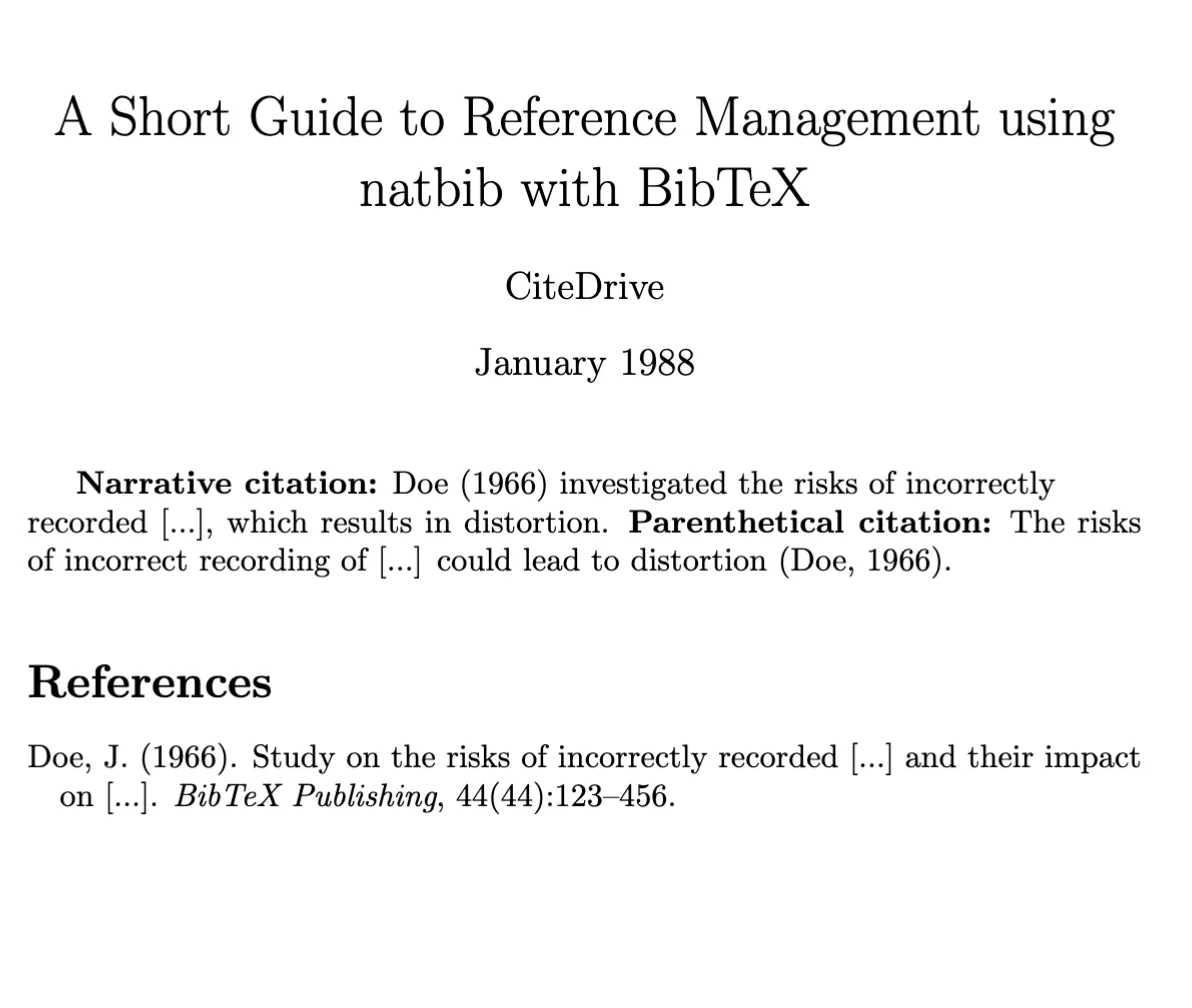
For those inclined towards numeric citation styles, here’s how you adapt natbib:
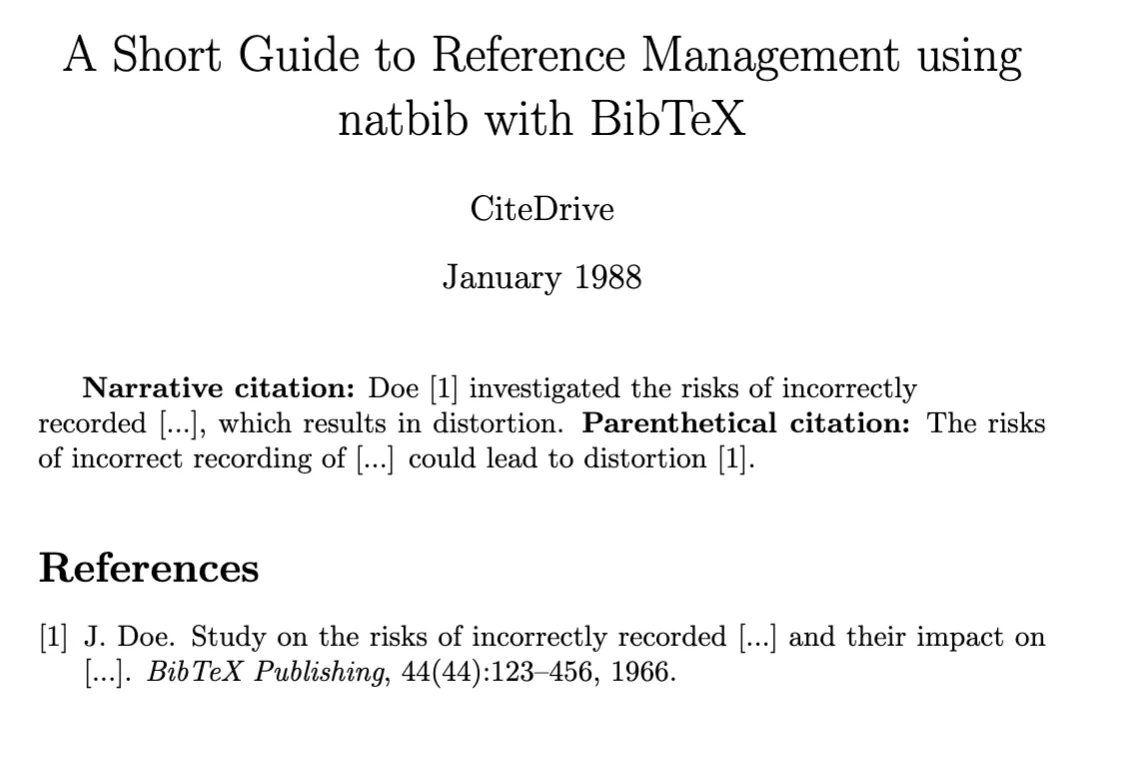
Deep Dive: Exploring the cite{*} Commands in natbib
Understanding the range of cite{*} commands provided by natbib allows you to cite sources efficiently. This table breaks down their outputs:
Other natbib commands, such as \citealp and \citealt , offer additional flexibility by suppressing brackets. Discover the entire range of commands in the Reference sheet for natbib usage .
Appendix: Mastering the Options for natbib
When working with natbib , customizing its behavior can make your workflow smoother. Here’s a breakdown of the options available via \usepackage[options]{natbib} :
Further Reading and Sources
- Dive deeper into bibliography management with Bibliography management with natbib on Overleaf.
- Familiarize yourself with different bibliography styles with Natbib bibliography styles on Overleaf.
- For a handy cheat sheet, check out the Reference sheet for natbib usage .
Wrapping Up
Harnessing natbib with BibTeX simplifies reference management in LaTeX. This guide offered a comprehensive walkthrough from basic setups to intricate citation styles. For more insights into LaTeX and its many functionalities, explore our collection of in-depth guides.
How to cite a website in LaTeX
There are multiple ways to cite a website in LaTeX, but I find this the easiest and quickest -
Use the following as bib entry -
And use url package in your tex file -
Written by Anupama Aggarwal
Related protips, switch to select bibtex or biber., the texmaker "solve my problems" user command, using font awesome with (xe)latex, have a fresh tip share with coderwall community.
No Search Results
- Bibliography management with natbib
When it comes to bibliography management in L a T e X , the package natbib is a package for customising citations (especially author-year citation schemes) when using BibTeX . This article explains how to use natbib to format and cite bibliographic sources.
Note : If you are starting from scratch it's recommended to use biblatex because that package provides localization in several languages, it's actively developed and makes bibliography management easier and more flexible. However, note that most journals still use bibtex and natbib .
- 1 Introduction
- 2 Basic usage
- 3 The bibliography file
- 4 Adding the bibliography in the table of contents
- 5 Reference guide
- 6 Further reading
Introduction
A minimal working example is presented below:
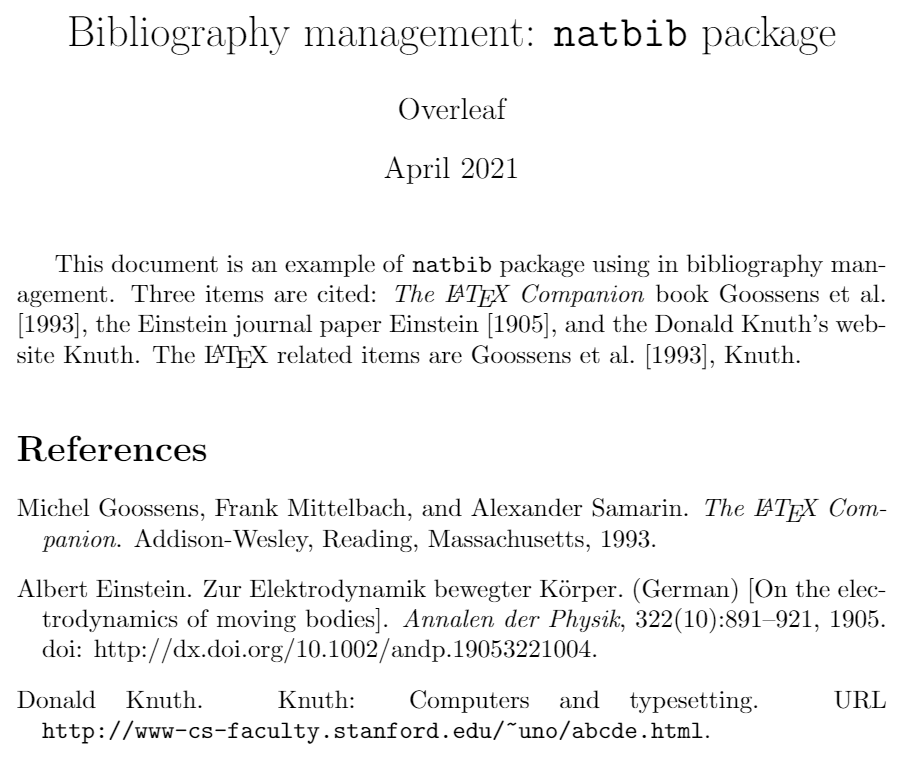
In this example there are four basic commands to manage the bibliography:
Open an example of the natbib package in Overleaf
Basic usage
A simple working example was shown at the introduction, there are more bibliography-related commands available.
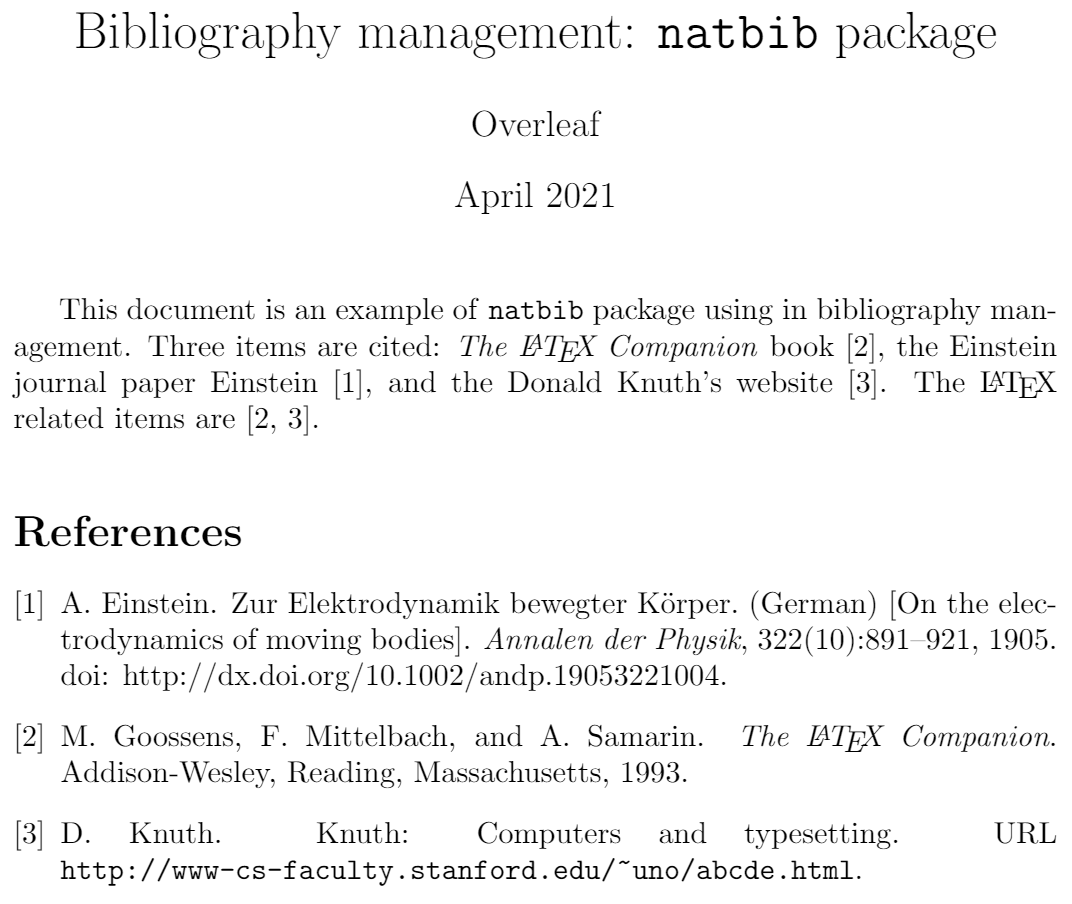
There are a few changes in this example:
- The options square and numbers in \usepackage[square,numbers]{natbib} enable squared brackets and numeric citations respectively. See the reference guide for a list of package options
- The styles abbrvnat is used here, see bibliography styles
- The command \citet adds the name of the author to the citation mark, regardless of the citation style .
Open another example of the natbib package in Overleaf
The bibliography file
The bibliography files must have the standard bibtex syntax and the extension .bib. They contain a list of bibliography sources and several fields with information about each entry.
This file contains records in a special format, for instance, the first bibliographic reference is defined by:
The information in this file can later be printed and referenced within a L a T e X document, as shown in the previous sections, with the command \bibliography{sample} . Not all the information in the .bib file will be displayed, it depends on the bibliography style set in the document.
Adding the bibliography in the table of contents
If you want the bibliography to be included in the table of contents, importing the package tocbibind in the preamble will do the trick:
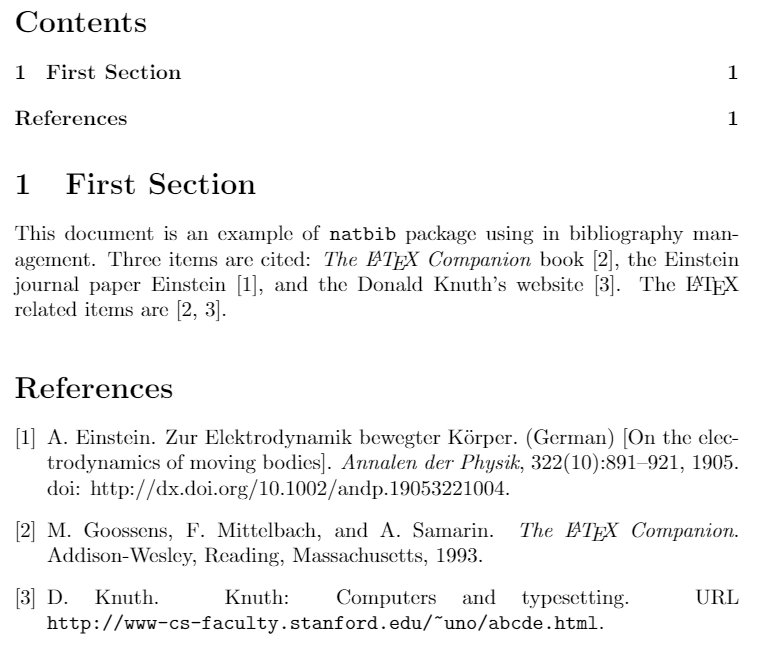
Open an example of natbib and table of contents in Overleaf
Adding the line
to the preamble will print the "References" or "Bibliography" in the table of contents, depending on the document type. Be careful, it will also add other elements like the Index, Glossary and list of Listings to the table of contents. For more information see the tocbibind package documentation .
Reference guide
natbib package options
- round for round parentheses
- square uses square brackets
- curly curly braces
- angle angle braces or chevrons
- semicolon separates multiple citations with semicolons
- colon same as semicolon
- comma separate multiple citations with commas
- authoryear for author-year citations
- numbers for numerical citations
- super superscripts for numerical citations, as in Nature
- sort orders multiple citations according to the list of references
- sort&compress same as sort but multiple numerical citations are compressed if possible
- compress compress without sorting
- longnamefirst the full name of the author will appear in the first citation of any reference
- sectionbib To be used with the package chapterbib to add the bibliography to the table of contents as a unnumbered section instead of an unnumbered chapter
- nonamebreak prevents hyphenation of author names
- elide to omit common elements of merged references
Standard entry types
Most common fields used in BibTeX
Further reading
For more information see
- Natbib bibliography styles
- Natbib citation styles
- Bibliography management with biblatex
- Bibliography management with bibtex
- natbib documentation at CTAN web site
- tocbind package documentation
- International language support
- Table of contents
- Documentation Home
- Learn LaTeX in 30 minutes
Overleaf guides
- Creating a document in Overleaf
- Uploading a project
- Copying a project
- Creating a project from a template
- Using the Overleaf project menu
- Including images in Overleaf
- Exporting your work from Overleaf
- Working offline in Overleaf
- Using Track Changes in Overleaf
- Using bibliographies in Overleaf
- Sharing your work with others
- Using the History feature
- Debugging Compilation timeout errors
- How-to guides
- Guide to Overleaf’s premium features
LaTeX Basics
- Creating your first LaTeX document
- Choosing a LaTeX Compiler
- Paragraphs and new lines
- Bold, italics and underlining
Mathematics
- Mathematical expressions
- Subscripts and superscripts
- Brackets and Parentheses
- Fractions and Binomials
- Aligning equations
- Spacing in math mode
- Integrals, sums and limits
- Display style in math mode
- List of Greek letters and math symbols
- Mathematical fonts
- Using the Symbol Palette in Overleaf
Figures and tables
- Inserting Images
- Positioning Images and Tables
- Lists of Tables and Figures
- Drawing Diagrams Directly in LaTeX
- TikZ package
References and Citations
- Bibtex bibliography styles
- Biblatex bibliography styles
- Biblatex citation styles
- Multilingual typesetting on Overleaf using polyglossia and fontspec
- Multilingual typesetting on Overleaf using babel and fontspec
- Quotations and quotation marks
Document structure
- Sections and chapters
- Cross referencing sections, equations and floats
- Nomenclatures
- Management in a large project
- Multi-file LaTeX projects
- Lengths in L a T e X
- Headers and footers
- Page numbering
- Paragraph formatting
- Line breaks and blank spaces
- Text alignment
- Page size and margins
- Single sided and double sided documents
- Multiple columns
- Code listing
- Code Highlighting with minted
- Using colours in LaTeX
- Margin notes
- Font sizes, families, and styles
- Font typefaces
- Supporting modern fonts with X Ǝ L a T e X
Presentations
- Environments
Field specific
- Theorems and proofs
- Chemistry formulae
- Feynman diagrams
- Molecular orbital diagrams
- Chess notation
- Knitting patterns
- CircuiTikz package
- Pgfplots package
- Typesetting exams in LaTeX
- Attribute Value Matrices
Class files
- Understanding packages and class files
- List of packages and class files
- Writing your own package
- Writing your own class
Advanced TeX/LaTeX
- In-depth technical articles on TeX/LaTeX
Get in touch
Have you checked our knowledge base ?
Message sent! Our team will review it and reply by email.
Email:

IMAGES
VIDEO
COMMENTS
I'm looking to cite a number of web pages using bibtex and I was wondering if there was a specific template of the form @<template name here> for doing that. ... The reason is basically because LaTeX may not handle an emtpy string well instead of no return, when building the citation text.
Here, the bibliography is divided in 4 sections. The syntax of the commands used here is explained below: \printbibliography[type=article,title={Articles only}] Only prints entries whose type is "article", and sets the title "Articles only" for this section. The same syntax works for any other entry type.
To cite a website using BibLaTeX, you need to follow the following steps: Step 1: Find the BibLaTeX entry type for a website. In BibLaTeX, the entry type for a website is @online. Step 2: Collect the required information for the website citation. The required information for a website citation in BibLaTeX is the same as BibTeX.
together with the thebibliography block from before, this is what gets rendered into your PDF when you run a \(\mathrm{\LaTeX}\) processor (i.e. any of latex, pdflatex, xelatex or lualatex) on your source file:. Figure 1: Citing entries from a thebibliography list. Notice how each \bibitem is automatically numbered, and how \cite then inserts the corresponding numerical label.
Using BibLaTeX. If you use BibLaTeX, which we recommend, the @online entry type is inherently supported and works without a further tweak. You can enter the URL and access date in the fields url and urldate, respectively. @online{CiteDrive2022, title = {CiteDrive brings reference management to Overleaf}, author = {CiteDrive, Inc}, year = 2022,
In this video, i will teach you about how to properly cite a web page in LaTeX. For this, we will use 'natbib' and 'hyperref' packages.-----...
In order to cite references, you first need to create a separate bibliography file ending with a .bib extension within your LaTeX project. You can do that by clicking on the New File icon on the upper-left corner of the screen. Then, enter your file name. Note that the default file extension in LaTeX is .tex. Your bibliography file must end in ...
verbose Citation style that prints a full citation when the entry is cited for the first time and a short version afterwards. reading Citation style that goes with the bibliography style by the same name. Loads the authortitle style. There are other non-standard citation styles popular in different journals and thesis In Sciences:
Summary. Generate a bibliography with BibTeX and BibLaTeX. First define a .bib file using: \bibliography {BIB_FILE_NAME} (do not add .bib) For BibTeX put the \bibliography statement in your document, for BibLaTeX in the preamble. BibTeX uses the \bibliographystyle command to set the citation style.
numeric style). Basic LaTeX comes with a few .bst style files; others can be downloaded from the web • To insert a citation in the text in the specified output style - insert the \cite command e.g. \cite{1942} where 1942 is the unique key for that reference. Variations on the \cite command can be used if using packages such as natbib (see below)
BIBTEX Citation Generator >. Cite a Website. Citation Machine® helps students and professionals properly credit the information that they use. Cite sources in APA, MLA, Chicago, Turabian, and Harvard for free.
In this simple LaTex document, five BibTex entries are cited. The bibliography style used is "plain", and the BibTex entries are from the database "Mybibtex". \documentclass{article} \begin{document} \title{About JabRef} \author{Author Name} \maketitle. JabRef is an open source reference management software for BibTex \cite ...
How to Cite a Website in BibTeX. BibTeX is a tool and a file format used for managing citations and bibliographies in LaTeX documents. Since citing websites requires a hack, there are a few things to remember when referencing a website in a BibTeX document. To simplify matters, BibLaTeX was developed.
Introduction to natbib and Its Strengths. The natbib package extends the capabilities of the standard \cite{*} command in LaTeX. It particularly shines in in-text citations with various options and customizations, especially for author-year schemes and displaying textual and parenthetical citations when integrated with BibTeX.
Introduction and example. When using BiBTeX, the bibliography style is set and the bibliography file is imported with the following two commands: \bibliographystyle{ stylename } \bibliography{ bibfile } where bibfile is the name of the bibliography .bib file, without the extension, and stylename is one of values shown in the table below . Here ...
How to cite a website in LaTeX. #latex. #bibtex. There are multiple ways to cite a website in LaTeX, but I find this the easiest and quickest -. Use the following as bib entry -. @MISC{Anu:2013, author = {Aggarwal, Anupama}, title = {This is how you cite a website in latex}, month = may,
To create a new bibliography file in your Overleaf project, in the editor, click New File icon: An input box will appear for you to set the name of the new file. The file should have the .bib extension, in this example it is called mybibliography.bib. Now click on Create. A new file will be listed in the left panel, click it to edit its contents.
In this example there are four basic commands to manage the bibliography: \usepackage{natbib} Imports the package natbib. \bibliographystyle{unsrtnat} Sets the bibliography style unsrtnat. See the article about bibliography styles for more information. \cite{labelcompanion} Prints a reference to the citation entry, what is printed depends on ...